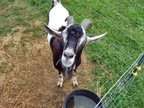For centuries, goats had been one of man’s hardiest domesticated animals. Supplying man its milk and meat, the goats had thrived even in the most hostile environments on earth. However, this dependable animal also has to have proper goat care.
Like all animals, goats also suffer a variety of diseases, some of which are dangerous and fatal to them. As their caretaker, you must at least be in the know about their most common health enemies.
Coccidia
These are intestinal parasites that cause foamy, bloody diarrhea and dull dry coats. A goat with coccidiosis (coccidia infestation) sometimes has no obvious symptoms at all.
Young kids at four months are at their highest risk and should be treated at least once. The most obvious symptom is that they are not growing as well as they should.
There are medications specific to this disease. If in doubt, you can take a stool sample to a veterinarian who specializes in ruminant animals.
Ketosis
Also known as pregnancy toxemia, ketosis happens late in a doe’s pregnancy. Symptoms include depression, disinterest in food, poor muscle control and balance.
Ketosis sometimes occurs when the doe is carrying two or more kids, or is very fat. The disease is caused by the sudden extra demand for energy by the unborn kids and the inability of the doe to eat enough to provide this energy.
Many does test positive for ketone bodies in their urine. This is a toxic by-product when the doe rapidly metabolizes fat in her body.
Propylene glycol at 2 to 3 ounces twice a day can help. To prevent this, do not let the doe get fat in pregnancy. In the last month of pregnancy, provide her with 1 to 2 pounds of grain in addition to hay.
Caprine Arthritis Encephalitis Syndrome (CAE)
This is a viral disease, usually transmitted by adults to young kids through contact or milk from an infected doe to her kid.
Symptoms include weakness in the rear legs, without fever or loss of appetite. However, the unused legs lose muscle strength and the kid eventually dies.
In older goats, symptoms are seen in swollen joints, especially the knees. The disease develops slowly. After 2 years, the animal has difficulty using its legs.
There are no corrective procedures or treatments. Preventive measures include isolating the kids at birth and raising them on pasteurized goat milk to prevent the spread.
During purchase, make sure a goat is free from CAE. Unfortunately, blood tests only checks for antibodies. A kid might be infected but is not yet producing antibodies.
Mastitis
This is an inflammation of the mammary gland of the animals caused by bacteria. Symptoms include swelling, heat, pain, tissue discoloration and abnormal milk.
The most common causes include rough treatment and unclean milking practices.
For preventive measures, wash the goat’s udders before milking. Spray the teats with a teat dip after milking. Wash your hands before and after milking each goat to prevent spreading the disease.
It is important to consult a vet since there are different strains of bacteria that cause mastitis. If left untreated, the doe may die or lose the udder.
Other diseases
There are minor illnesses that can strike your herd, but these four are the most virulent among all others. Goat care also means being extra alert to spot these deadly four.
Selengkapnya...






